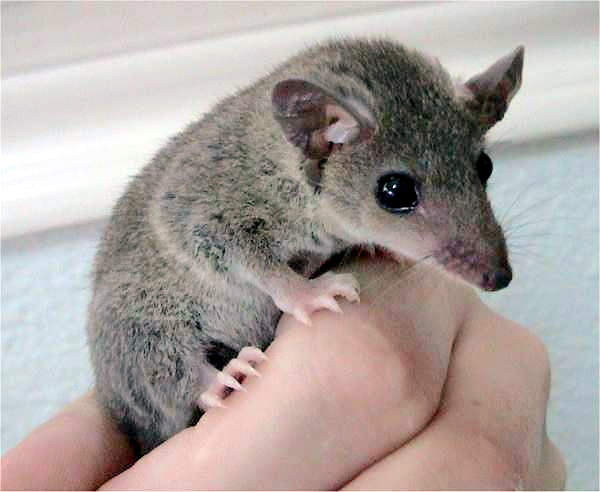In world’s first genetically engineered marsupials, scientists get a fresh window into human biology
By Megan Molteni,
STAT
| 07. 21. 2021
Photo licensed for use by CC BY-SA 2.5
When the pile of opossums arrived at John VandeBerg’s lab from the Smithsonian’s National Zoo in 1978, the geneticist had an ambitious plan for the soft-eyed, hamster-sized animals. He wanted to domesticate them to live in a lab anywhere on the planet. Mice were well and good, but imagine what biomedical insights might be lurking inside marsupials, he thought. Their young, rather than being encased inside a uterus, develop attached to a nipple in a pouch or on a belly where they’re much easier to observe.
VandeBerg succeeded, and today manages the largest Monodelphis domestica colony in the world at the University of Texas Rio Grande Valley School of Medicine. More than a dozen labs have taken up research projects with the gray short-tailed opossums, who hail from South America. But the same quirk that makes them a compelling model organism has also made them more difficult to study than he once imagined.
Shortly after ovulation, marsupial moms secrete layers of mucus and protein around their eggs, covering them in a hard...
Related Articles
Following a long-standing CGS tradition, we present a selection of our favorite Biopolitical Times posts of the past year.
In 2025, we published up to four posts every month, written by 12 authors (staff, consultants and allies), some in collaboration and one simply credited to CGS.
These titles are presented in chronological order, except for three In Memoriam notices, which follow. Many more posts that are worth your time can be found in the archive. Scroll down and “VIEW...
By Jonathan Matthews, GMWatch | 12.11.2025
In our first article in this series, we investigated the dark PR tactics that have accompanied Colossal Bioscience’s de-extinction disinformation campaign, in which transgenic cloned grey wolves have been showcased to the world as resurrected dire wolves – a...
By Jenny Lange, BioNews | 12.01.2025
A UK toddler with a rare genetic condition was the first person to receive a new gene therapy that appears to halt disease progression.
Oliver, now three years old, has Hunter syndrome, an inherited genetic disorder that leads to physical...
By Simar Bajaj, The New York Times | 11.27.2025
A common cold was enough to kill Cora Oakley.
Born in Morristown, N.J., with virtually no immune system, Cora was diagnosed with severe combined immunodeficiency, a rare genetic condition that leaves the body without key white blood cells.
It’s better...




